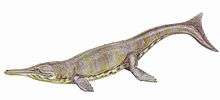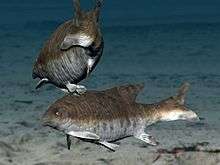1830 in paleontology
| |||
|---|---|---|---|
|
Paleontology or palaeontology (from Greek: paleo, "ancient"; ontos, "being"; and logos, "knowledge") is the study of prehistoric life forms on Earth through the examination of plant and animal fossils.[1] This includes the study of body fossils, tracks (ichnites), burrows, cast-off parts, fossilised feces (coprolites), palynomorphs and chemical residues. Because humans have encountered fossils for millennia, paleontology has a long history both before and after becoming formalized as a science. This article records significant discoveries and events related to paleontology that occurred or were published in the year 1830.
Archosauromorphs
Newly named basal archosauromorphs
| Taxon | Novelty | Status | Author(s) | Age | Unit | Location | Notes | Images |
|---|---|---|---|---|---|---|---|---|
|
Gen. nov. |
Valid |
Guadalupian, 260–251 mya |
Pirambola Formation |
One of the most primitive archosauromorphs. Previously considered to be related to Prolacerta within Prolacertiformes, but now a new genus shows that they were in fact not closely related.[3] |
| |||
Dinosaurs
Newly named dinosaurs
Data courtesy of George Olshevsky's dinosaur genera list.[4]
| Taxon | Novelty | Status | Author(s) | Age | Unit | Location | Notes | Images |
|---|---|---|---|---|---|---|---|---|
|
Gen. nov. |
Christian Erich Hermann von Meyer |
Oxfordian, 161 mya |
Vaches Noires, Chipping Norton |
The remains of Streptospondylus were the first dinosaurian remains to be described, however, their identification was thought to be teleosaurid or metriorhynchid.[5] The type species, S. altdorfensis, was described by von Meyer in 1832,[6] and another possible species, S. cuvieri, was named in 1842 by Sir Richard Owen.[7] |
| |||
Crocodylomorphs
Newly named crocodylomorphs
| Taxon | Novelty | Status | Author(s) | Age | Unit | Location | Notes | Images |
|---|---|---|---|---|---|---|---|---|
|
Gen. nov. |
Valid |
Christian Erich Hermann von Meyer |
Late Jurassic (Kimmeridgian-Tithonian) |
| ||||
|
Gen. nov. |
Christian Erich Hermann von Meyer |
Toarcian to Berriasian, 183–142 mya |
Oxford Clay Formation, Kimmeridge Clay, Holzmaden, Monheim, Hondelage |
Now considered a junior synonym of Steneosaurus. Steneosaurus is known from many species that existed from the Early Jurassic to Early Cretaceous, which form a monophyletic group when S. pictaviensis and S. megarhinus are excluded.[8] |
| |||
|
Gen. nov. |
Valid |
Christian Erich Hermann von Meyer |
Callovian to Kimmeridgian, 167–155 mya |
Oxford Clay Formation, Kimmeridge Clay, La Voulte-sur-Rhône (lagerstätte) |
Many species have been referred to Metriorhynchus since 1830, yet recent studies show that only three species are valid and referrable to the genus, the type M. geoffroyii, M. superciliosus, and M. hastifer.[9] |
| ||
Fish
Newly named fish
| Taxon | Novelty | Status | Author(s) | Age | Unit | Location | Notes | Images |
|---|---|---|---|---|---|---|---|---|
|
Gen. nov. |
Christian Erich Hermann von Meyer |
This genus is now considered a junior synonym of Lepidotes. Although previously known from species ranging between 205 and 100 mya, a 2012 study found only from species ranging in the Late Jurassic to be in the genus, and reassigned the rest.[10] |
| |||||
References
- ↑ Gini-Newman, Garfield; Graham, Elizabeth (2001). Echoes from the past: world history to the 16th century. Toronto: McGraw-Hill Ryerson Ltd. ISBN 9780070887398. OCLC 46769716.
- 1 2 3 4 5 von Meyer, H. (1830). von Oken, Isis, ed. "Achte Versammlung der Naturforscher und Ärzte zu Heidelberg": 517–519.
- ↑ Borsuk–Białynicka, M.; Evans, S.E. (2009). "A long–necked archosauromorph from the Early Triassic of Poland" (PDF). Palaeontologia Polonica. 65: 203–234.
- ↑ Olshevsky, George. "Dinogeorge's Dinosaur Genera List". Retrieved 2008-08-07.
- ↑ Cuvier, G. (1808). "Sur les ossements fossiles de crocodiles et particulièrement sur ceux des environs du Havre et d'Honfleur, avec des remarques sur les squelettes de sauriens de la Thuringe". Annales du Muséum d’Histoire naturelle de Paris. 7: 73–110.
- ↑ von Meyer, H. (1832). "Paleologica zur Geschichte der Erde". Frankfurt am Main: 560.
- ↑ Owen, R. (1842). "Report on British fossil reptiles". Report of the British Association for the Advancement of Science. 11: 60–204.
- ↑ Mueller-Töwe, I.J. (2005). "Phylogenetic relationships of the Thalattosuchia" (PDF). Zitteliana. A45: 211–213.
- ↑ Cau, A.; Fanti, F. (2010). "The oldest known metriorhynchid crocodylian from the Middle Jurassic of North-eastern Italy: Neptunidraco ammoniticus gen. et sp. nov.". Gondwana Research. 19. doi:10.1016/j.gr.2010.07.007.
- 1 2 3 López-Arbarello, A. (2012). "Phylogenetic Interrelationships of Ginglymodian Fishes (Actinopterygii: Neopterygii)". PLoS ONE. 7 (7): e39370. doi:10.1371/journal.pone.0039370. PMC 3394768
 . PMID 22808031.
. PMID 22808031.






